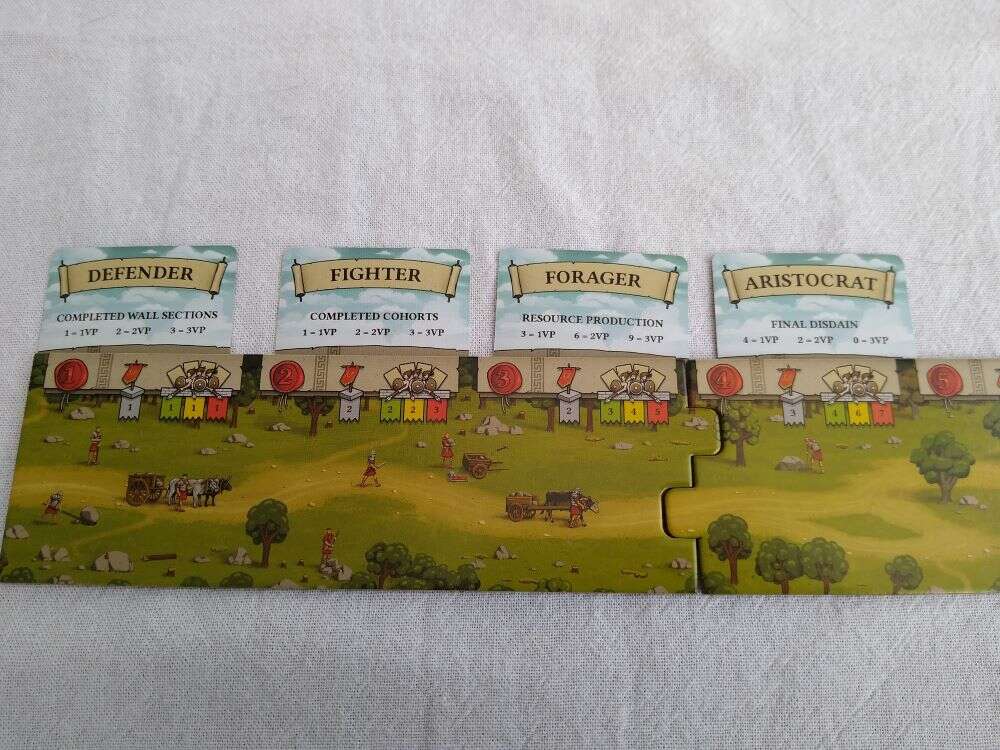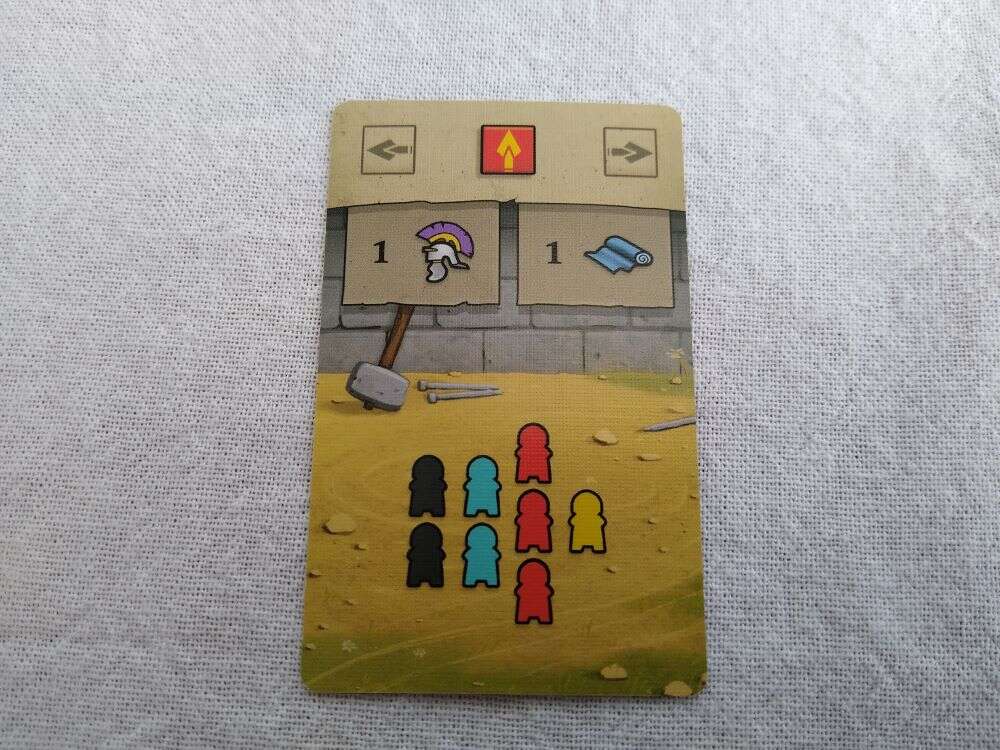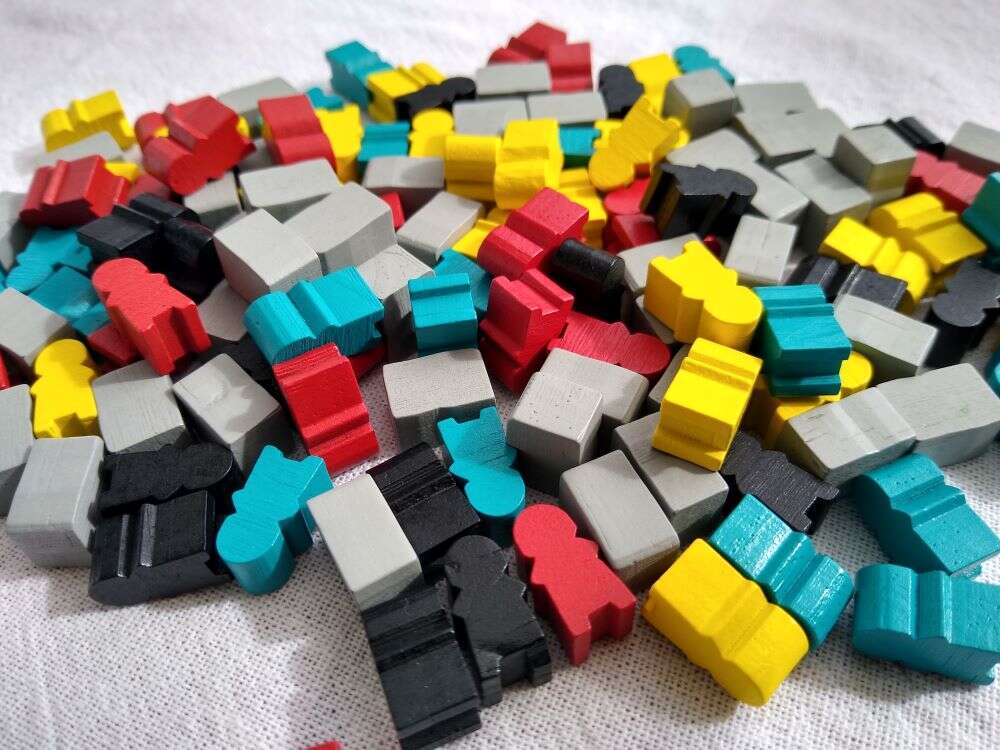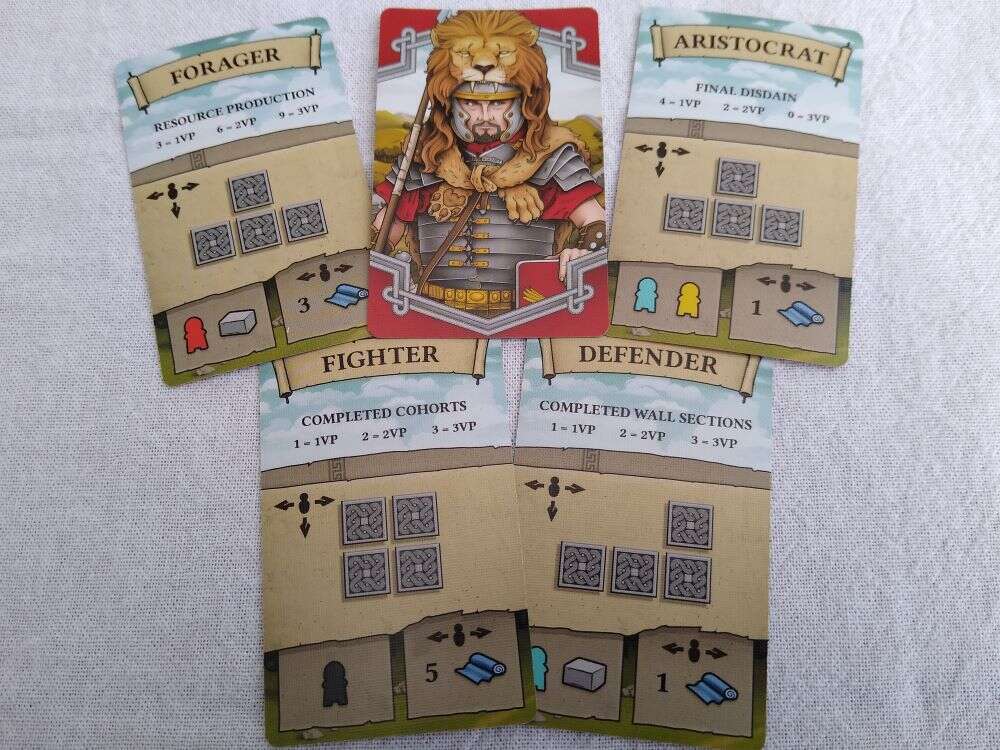Play Time: 30-60 Min / Players: 1-6 / Complexity: High / Age: 12+ / Publisher: Garphill Games / Designer: Bobby Hill
Hadrian’s Wall Ratings and Summary
Summary
Teen rating from our son (15).
Hadrian’s Wall is a unique combination of worker placement and a fairly chunky flip & write game. It’s a little overwhelming at first but there is plenty to enjoy with lots of combos to trigger and an exceptional solo campaign. Just don’t expect much in the way of player interaction here.
Pros
- Lots of opportunities for satisfying combos
- Plenty of options on the large player sheets to explore
- Quick low fuss set up and tear down
- Unique and interesting cross over between worker placement and flip & write games
- Iconography is clear and helpful on the sheets
- Solo campaign is excellent and adds some nice variety.
Cons
- Minimal interaction
- Can be quite overwhelming at first with so many spaces on the sheets
- There is not much variation from game to game, although the campaign helps add variation to the solo mode.
What You Will Find in Our Hadrian’s Review
Sponsored Links:
So, what do I know about Hadrian’s Wall? Well… it’s a wall built in England during Roman Emperor Hadrian’s reign but is now in various states of disrepair, which is to be expected for a structure almost 2,000 years old. Except now it’s also a flip & write style board game from local New Zealand publisher Garphill Games and designer Bobby Hill. So, there we go a kiwi connection to the Roman Empire. But you’re not here for a history lesson or to see me try to draw connections between the Roman Empire and New Zealand, you want to know if this game is any good. This game does some amazing things but the answer to whether or not you will like it is….well… it depends. Ok that’s not a great answer but read on and I’ll explain.
How to Play Hadrian’s Wall
In Hadrian’s Wall you take on the role of a Roman general in charge of constructing a milecastle and bordering wall as your contribution to this massive Roman construction effort. It’s not just about the wall and fortifications though, you will need to establish cohorts to guard your wall and do your part to encourage the supporting town to flourish with investments in performances, trade, religion, public baths and even training gladiators.

Your goal is to gain as many points as possible by moving up four separate points tracks for renown, piety, valour, and discipline. You have 6 years (rounds) to gain as many points as possible, the catch is after each year the Picts will attack and test your defences. If you successfully repel their attacks, you gain recognition by moving up the valour track, but if you fail you are penalised with disdain which reduces your points. Roman society tended to judge failure harshly I guess and this represents you falling out of favour.
Each year has three phases. The first phase involves gaining workers and resources by flipping a fate card and selecting one of two path cards, these will determine what resources you receive along with any extra resources from buildings already constructed or by moving up the resource production track. The path card you don’t select for resources will be tucked under your player board and provide a points bonus for achieving certain goals. So by the end of the game you will have a total of six path cards with various goals available to you to try to achieve.

The second phase involves using your workers and resources to cross off sections of your two large player sheets and gaining any bonuses marked. Workers come in different types and so are good at different things. Soldiers can improve defences and help with scouting, engineers can help building out your fort and other main buildings, citizens are used for advancements in your town and servants generally provide resources. Resources are used to build out walls and help with construction of buildings.
The final phase involves cards from the fate deck being flipped to determine where the Picts attack (left, centre or right) and whether they have been successfully repelled by your defences. If you happen to have at least as many cohorts in that section of the wall as Pict attacks then you repel their attacks, if not they get through resulting in increased disdain and a points penalty.
The best way to illustrate how it all works is by running through a hypothetical example. I may start the round by gaining a bunch of worker meeples and resources as outlined above. I could use a citizen meeple to cross off a space in the patrician track. That space then gives me a resource that I spend to cross of a space building out my main wall. That space then gives me another citizen meeple, great I get back my original meeple. Now I use that citizen meeple I just gained to cross off a spot on the performers track. That now gives me an engineer I can use, I now use the engineer to cross out another space on my fort which then gives me….you get the picture. That was just one meeple, you get a bunch of them each turn so that gives you plenty of scope to explore both sheets and create multiple combos. So satisfying!

Once I have consumed all the workers I have, I then flip cards from the fate deck to see where the Picts will attack. Let’s say I am on round 3 and playing on easy mode. I would flip three fate cards and see where the attacks come from. Maybe it turns out like this, first card left, second card left, third card centre. I may by this stage have two cohorts on the left and centre sections of my wall in which case I have repelled the attacks and can claim the reward of two valour which pushes me up the valour track gaining me points.
You can see that just about everything you do in this game tends to provide a bonus or points or opens up some extra spaces on the sheets you can access. I won’t go through the specifics of each area on the pages but at a high level one sheet is concerned with building up your defences, production and points and another sheet is dedicated to making improvements to your town. That should be enough to give you a sense of how it all works.
Hadrian’s Wall Gameplay Experience
I have been enjoying flip/roll and write games a lot lately, with the excellent Dinosaur Island Rawr ‘n Write being a current favourite of mine. So, I have been on the lookout for other great verb & write type games. I am also a big fan of Garphill Games given my experiences with the amazing Paladin’s of the West Kingdom. Both of these factors got me interested in Hadrian’s Wall, I was hoping I would get all that great combo action from Paladins but in a quicker, low admin flip & write game.
Given what I just said let me start by saying Hadrian’s Wall delivered pretty much what I was after in this game. There are some minor caveats which are not a deal breaker for me but could be for others. But overall, I think this is a unique, fun and satisfying game, especially for solo play, but I will get to that later.

Let me start with one of the key reasons I got this game, the combo factor. I was eagerly looking forward to a game full of that addictive, engrossing and satisfying feeling of setting off ever more impressive chain reactions. This is something I love in games, feeling like you have cleverly orchestrated a snow ball effect that accumulates more and more points or bonuses. Well, Hadrian’s Wall has truckloads of combo factor. Just about anything I mark off on the page grants me some more workers or resources or unlocks the potential of other rewards or pushes me up one of the four points tracks. Even when I had no idea what I was doing in my first few games, I still felt like I was doing very impressive things. This is an aspect of the game that got me hooked immediately.
But the combo factor was not the only reason I was interested in this game. I am now unfortunately more starved of time than I used to be, between work, kids and life in general time is at a premium for me. Now a days I want games that packs as much fun factor as possible into a low fuss package that I can play in less than an hour. It’s a shame when a game I really enjoy takes a lot of set up time and in the end I play it less frequently because of it. But Hadrian’s Wall can be set up in minutes. Better still a game can easily be played in an hour, less when players are familiar with it because most of the game is played simultaneously by all players.
The simultaneous nature of the game also leads to less down time, although this will depend on how much time your opponents take analysing the very large and slightly overwhelming player sheets. Which brings me to my first negative. There is no escaping it, the array of options on the two large pages make it slightly intimidating at first. It can be quite hard to teach, not necessarily because the individual actions are hard to get your head around, but because there are just so many of them. For that reason, I think this wouldn’t make a good intro to flip/roll & write type games.
But that breadth of options is also one of the reasons why I enjoy it so much, there is just so much you can explore on those pages. I can do so many different things in this game. Build up my wall or garrison to defend against the Picts, engage in trade, scout for resources, look to religion to bolster my chances or even train up some gladiators. It’s a joy to try different avenues and see the impact they have on the game.
Overall, I can’t think of any game quite like Hadrian’s Wall, the way that workers and resources are incorporated into a flip & write style game is really cool and it just works so well. There is something satisfying about physically picking up extra meeples as a bonus and then using them in the same turn, rather than just crossing off spaces and adding points.

So far so good, so what are the other caveats I mentioned in the intro? Well, there is hardly any player interaction in this game. I don’t think this makes it unenjoyable with other players but there aren’t really any opportunities to affect your opponents in this game. Everyone largely plays their game and marks off their sheet in isolation of the other players. There are some minor exceptions like trade and scouting but by in large this is multiplayer solitaire. There are still however, opportunities for some talking points, the main one being when fate cards are flipped for the Pict invasion. Usually along the lines of ‘gee you got lucky mate, one more attack on that left flank and you were done for’ or ‘hard luck mate most of those Picts got through, you’re going to need to rev up your garrison and get them to step up.’ But that’s about it.
The other thing to be aware of is that there is not a lot of variation from game to game. The game gives you so many options this is not likely to be an issue for a long while but worth being aware of.
Hadrian’s Wall Solo Experience
I think Hadrian’s Wall’s sweet spot is as a solo game, it is just so well suited to solo play. In fact, it made it our list of the best solo board games.
I can usually finish a solo game in between 35-45 minutes, for a game that feels as engaging and chunky as this that is perfect for me. It’s also no fuss, set up is a breeze and because most things are on the page, it’s a matter of scribbling out boxes and playing around with meeples.
In saying that the solo mode on its own would not have kept me as engaged without the campaign. The base solo mode is about reaching points targets which I think would become less motivating after a while. The campaign, however, is excellent and adds some much-needed variety to the game and some goals to achieve. It has 16 scenarios, and each not only has a win condition but also a stretch goal which you can achieve for some advantage in the next scenario.
Components

If you have bought Garphill Games before you will be familiar with the Garphill size box they use and this one feels very hefty. Most of it is due to the two large pads of player sheets that the game comes with. There should be plenty there to keep you going.
The other components include some decks of cards and of course the coloured meeples and resource tokens which are wooden. The quality of the cards and the wooden tokens is good and should hold up well over many plays.
I enjoy the artwork in this game from Sam Phillips and think it fits the theme well. But the standout is the way the icons are laid out to help you get to grips with what happens at each space. That coupled with a really well laid out rule book make this game a lot easier to get your head around than it might have otherwise been. Overall, the components are very well done.
Theme
The game includes many of the things I would expect from something focusing on Hadrian’s Wall and in general the Roman era. The inclusion of spaces on the sheet beyond just the fortifications works well and feels consistent with the era, public baths, gladiators, diplomats, trade it all feels like it fits the theme nicely.
The campaign also has a nice back story for each fort in the scenarios which is another nice touch. Overall, I think the theme is well implemented here.
Final Thoughts on Hadrian’s Wall
So far, I have played Hadrian’s wall 15 times at various player counts but mostly solo. I am almost half way through the campaign and will get plenty more plays in before the campaign is completed. In short, I am getting lots of value out of this chunky flip & write. I don’t mind the low player interaction and love the fact I can get such a chunky game to the table with no fuss set up and play it within the hour. But the best thing I like is the frequent and satisfying combos I get every time I play. In short, I really enjoy Hadrian’s Wall and am very pleased I have it in my collection.
My son enjoys the combos in this game but tends to not be a big fan of flip/roll & writes or games with low player interaction. So, he is not as big a fan of this game as I am.
So, who else might like this game? I think experienced players of verb and write type games who want a chunky experience would enjoy Hadrian’s Wall. I also think solo gamers who want a chunky and satisfying experience in under an hour would enjoy it.
Who might not like this game? I think people new to board gaming would struggle a bit with Hadrian’s Wall, this is not a good introduction to verb and write games or boardgames. People who want plenty of interaction in their games will find they don’t get that here.
Is Hadrian’s Wall easy to learn? The rule book and iconography is great but there is no escaping it, this is a complex game that will at first feel overwhelming to some.
What will Hadrian’s Wall teach my teen? Hadrian’s Wall will teach your teen a little bit of the history behind the game and also maybe spark interest in finding out more.
What age is appropriate for Hadrian’s Wall? The box says 12+ and I think that I wouldn’t go any younger than that. In fact, I think even at that age it would depend on whether they have had experience with other more modern/complex games.
Does Hadrian’s Wall have good replay value? With the included campaign I think replay value is good, especially given how broad the options are on the player sheets. However just be aware that without th campaign the game doesn’t vary a lot from game to game.
We hope you enjoyed our Hadrian’s Wall review. If you have any more questions or just want to share your thoughts on this game please leave a comment below, or get in touch through our contact page.
About the Authors
We are parents who love board gaming. We have three children and have been enjoying board games as a family ever since we had our first child. We share our real unbiased experiences and opinions on board games so you can decide if they are right for your family. We also write guides and articles to help you get the most out of your family game time. If you enjoy our content and want to support us you can do that through our Ko-fi page by clicking on the button below.
Strategy Tips
Before I get into these strategy tips, just be aware there are so many different pathways to follow in this game and so this is just what I have found to be general tips that worked well for me. The real fun though is in experimenting and exploring the massive pages to see how you can maximise your points. That said here are some tips that might help:
- Be aware the fort and granaries act as constraints. These areas are prerequisites for some areas on that particular player sheet. If you don’t build up your wall enough or have granaries built you may find you run out of viable options for resources. So, plan ahead and make sure you build your fort and granaries up before you need them.
- Hotels, workshops and roads are more useful the earlier they are built. This is because hotels and workshops generate workers each round. In the case of roads, they push you up points tracks each round. The earlier you get them the more options you will have throughout the game.
- The first spot on each citizen track is pretty much a freebie. Each citizen track is stacked with bonus workers, resources and points. The first spot on each of these will give you some bonus regardless of the track, be it workers or in the case of the patrician track resources. Getting all of these early will allow you to maximise your rounds.
- Ensure you don’t waste resources. This applies to workers too but I generally found when I was learning this game that if I wasn’t careful, I would end up wasting resources with no where to put them. So, how does this happen? Well let’s say you have generated a lot of resources in a round but don’t have your granaries or fort built up enough so can’t use any more resources on the wall or cippi. If you also don’t have any engineers to help build other buildings you may have to waste those resources because they can’t be carried over. A good way to avoid this is to plan ahead as outlined in my first point but also to ensure you have at least one building available that allows you to consume resource for benefits, like the market or public baths.
- Don’t be frightened of a little disdain. One or two disdain corresponds to a points penalty of 1 and 3 respectively. Don’t be too worried about the first couple of spaces on the disdain track, I tend to ignore these. The issue is if you start getting to the third and above where the negative points rack up quickly and that is best to avoid, as removing disdain through the public baths in my view is a bit of wasted effort. You are best to avoid that level of disdain to begin with, but how? Read below.
- Build up your defences steadily as the game progresses. I don’t think it is a good idea to ignore defences in this game because of the previous point above. In short, I try to keep pace with the increased threat each round. A good way I have found to build up defences is by investing in the wall, but that requires, you guessed it the fort and eventually granaries.
- Try to achieve your path goals. The path cards you tuck underneath your player board provide additional bonuses for achieving certain goals. Tying your plans to align with these goals is a good way to get a points boost.

